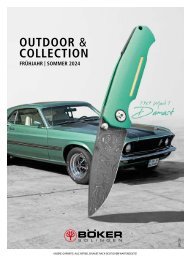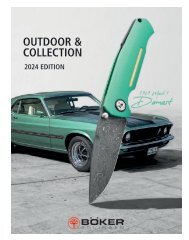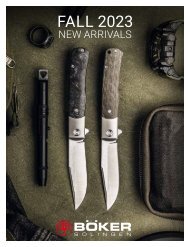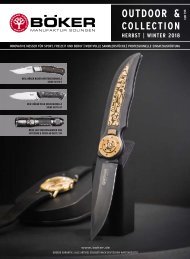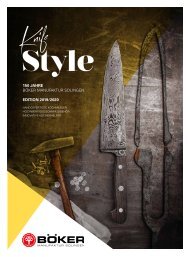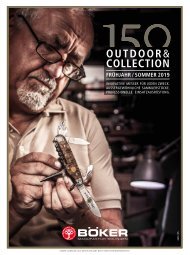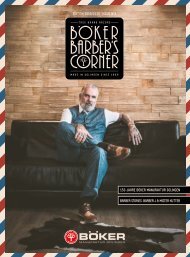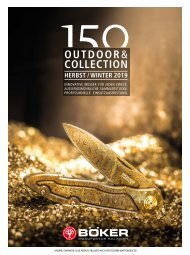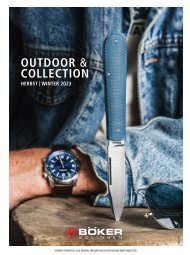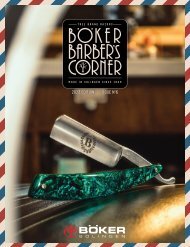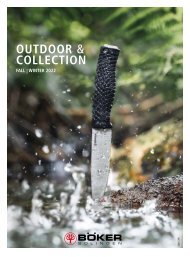Boker Knifestyle | EN Edition 2018 / 2019
Create successful ePaper yourself
Turn your PDF publications into a flip-book with our unique Google optimized e-Paper software.
36 CONSTRUCTION OF A KITCH<strong>EN</strong> KNIFE<br />
CONSTRUCTION METHODS & BLADE JOINTS<br />
The knife has been an essential universal tool for more than 2.4 million years. Knives are available in a wide variety of shapes and designs for<br />
almost any purpose. As a tool, kitchen implement, decorative object or collector’s item – people value the advantages of these sharp tools<br />
in every kitchen. The construction possibilities for a kitchen knife are almost as varied as the possible uses – from cutting fresh bread to<br />
carving a beef tenderloin or filleting fresh fish. At the <strong>Boker</strong> Manufactory, we use three different blade and handle joint designs, depending<br />
on the knife series.<br />
Each design has its own tradition and purpose, and offers different advantages in terms of production, handling and use. Despite all<br />
differences, these designs of <strong>Boker</strong> kitchen knives have one thing in common - they are all excellent and superior kitchen knives that you<br />
will never want to put down. Depending on your individual and personal preferences in terms of design, weight, ergonomics and balance,<br />
you are sure to find the right knife in our collection.<br />
Bevel<br />
Forged<br />
bolster<br />
Tang<br />
Cutting<br />
edge<br />
THE FORGED BOLSTER<br />
European kitchen knives are mainly used to cut with pressure.<br />
The die-forged bolster offers a few distinct advantages. For this<br />
cutting technique, the index finger or middle finger presses down<br />
on the end of the blade. Thanks to its three dimensional shape, the<br />
bolster serves as a comfortable pressure point. At the same time,<br />
its weight supports the cutting movement when the blade moves<br />
forward.<br />
The knives in our <strong>Boker</strong> Core series are die-forged with a<br />
bolster. Die-forging is a technique with roots in the early days of<br />
industrialization. First, a roughly shaped piece is cut off from the<br />
raw material. This piece is brought to a red heat and hammered<br />
into shape inside a massive form consisting of two halves, top and<br />
bottom. This process is also called drop forging. The bottom die<br />
serves as a counter surface. The die dropping down onto the blade<br />
is affixed to a drop hammer weighing two tons. The resulting blade<br />
blank needs to be soft-annealed before the blanks are deburred,<br />
which means that the excess material created during the forging<br />
process is removed. The blank is calibrated again on a knuckle joint<br />
press with 800 tons of pressing force. This process is particularly<br />
suitable for sharply contoured blade profiles.<br />
The bolster remains a technical challenge, even and especially<br />
after forging. A grinder now shapes the knife’s fine contour<br />
from the rough blank. The complex three-dimensional and conical<br />
structure of the bolster requires the grinder’s full experience and<br />
concentration. Careless handling can cause unsightly dents or<br />
notches at all junctions of the blade and handle.




